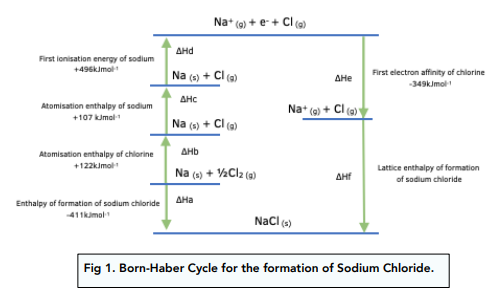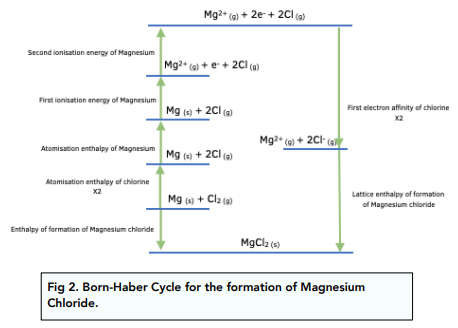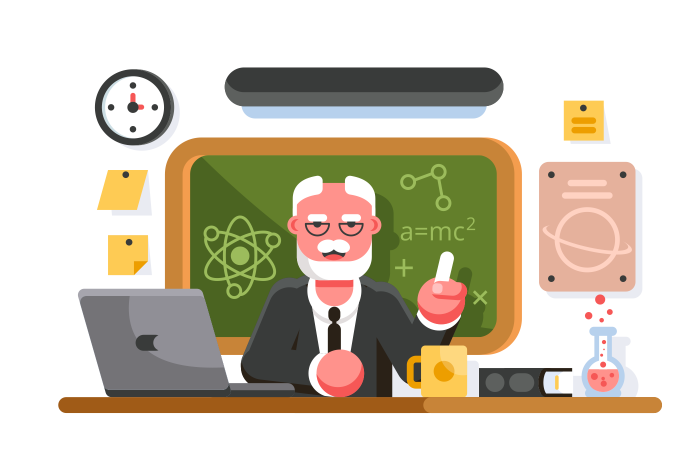Thermodynamic - Construction of Born-Haber Cycles (A-Level Chemistry)
Born-Haber Cycles
Born-Haber Cycles
Born-Haber Cycles and Hess’s Law
Lattice enthalpies cannot be directly measured, that’s why we use a Born-Haber cycle.
A Born-Haber cycle is a thermochemical cycle that includes every enthalpy change that is involved in the an ionic compound formation process. This is possible due to the principle of Hess’s Law.
Hess’s Law states that the total enthalpy change of a chemical reaction is the same independent of the route taken from products to reactants.
Example: Born-Haber of NaCl (Group 1)
Born Haber Cycles represents two possible routes to form an ionic compound form its elements in their standard state:
- A direct route – It involves only one step and it is represented by the enthalpy change of formation
- An indirect route – It involves changing the elements from their standard states to their gaseous ions before forming the ionic compound.
A Born-Haber cycle using the example of NaCl is shown in figure 1 below.
Downward arrows show negative values, therefore exothermic processes.
Upward arrows show positive values, therefore endothermic processes.

The direct route for the formation of NaCl involves the enthalpy change of formation of NaCl (ΔHa). It is an exothermic process and therefore is represented by a downwards arrow.
The indirect route for the formation of NaCl involves:
1. Enthalpy of atomisation of chlorine. It is an endothermic process and therefore is represented by an upwards arrow.

2. Enthalpy of atomisation of sodium. It is an endothermic process and therefore is represented by an upwards arrow.

3. First ionisation energy of sodium. It is an endothermic process and therefore is represented by an upwards arrow.

4. First electron affinity of chlorine. It is an exothermic process and therefore is represented by a downwards arrow.

5. Lattice enthalpy formation of sodium chloride. This is the second step in the indirect route, once we have already got the ions that make up the compound in their gaseous state. It is an exothermic process and therefore is represented by a downwards arrow.

Example: Born-Haber of MgCl2 (Group 2)
Born-Haber cycles involving Group 2 elements are slightly different and a few more steps are involved.

The process of working out the lattice enthalpy of formation is the same as group 1 elements except for a couple of things:
- The atomisation enthalpy of chlorine needs to be doubled. This is because there are 2 moles of chlorine ions in each mole of magnesium chloride.
- The second ionisation energy of magnesium needs to be added. This is due to elements in group 2 forming 2+ charge ions.
- The first electron affinity of chlorine needs to be doubled. This is because you form 2 moles of chlorine ions.
A Born-Haber cycle is a graphical representation of the enthalpy changes that occur during a chemical reaction. It is a useful tool for predicting and understanding the energetics of chemical reactions.
The purpose of a Born-Haber cycle is to provide a visual representation of the enthalpy changes that occur during a chemical reaction, including the lattice energy, bond dissociation energy, and electron affinity. By constructing a Born-Haber cycle, you can determine the enthalpy of formation of a compound and understand the factors that contribute to the energetics of a chemical reaction.
A Born-Haber cycle is constructed by starting with the elements that make up the compound in their standard states and tracking the enthalpy changes that occur as they are transformed into the final compound. The enthalpy changes associated with ionization, electron affinity, and bond formation are represented by the cycle’s various steps.
By constructing a Born-Haber cycle, you can obtain information about the energetics of a chemical reaction, including the enthalpy of formation of the compound and the lattice energy, bond dissociation energy, and electron affinity of the elements that make up the compound. You can also use a Born-Haber cycle to understand the factors that influence the energetics of a reaction and make predictions about the thermodynamics of chemical reactions.
The Born-Haber cycle is important in A-Level Chemistry because it provides a visual representation of the enthalpy changes that occur during a chemical reaction and helps students understand the energetics of chemical reactions. Understanding the principles of the Born-Haber cycle is essential for making informed predictions about the thermodynamics of chemical reactions and is a key component of A-Level Chemistry curricula.
The Born-Haber cycle is widely used in the chemical industry to make predictions about the energetics of chemical reactions and to design processes that are thermodynamically favorable. It is also used in materials science to predict the stability of compounds and the conditions under which they may decompose or react with other substances. Understanding the Born-Haber cycle is important for making informed decisions in a variety of industries and applications.






Still got a question? Leave a comment
Leave a comment